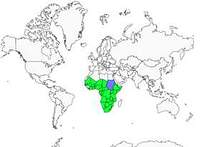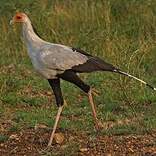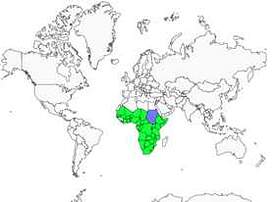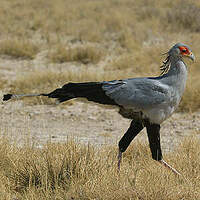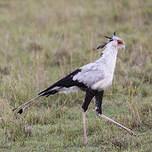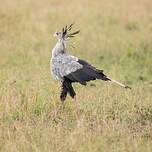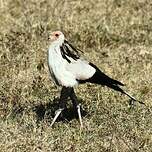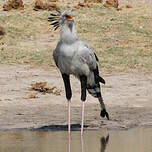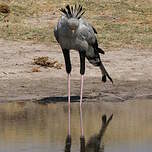Secretarybird
Sagittarius serpentarius - Messager sagittaire
Identification
The Secretarybird is a large diurnal raptor which inhabits sub-Saharan arid areas of Africa. Endemic to the African continent, it is a monotypic species, the only member of the Sagittaridae family. Because of its raptor body and long wading bird legs, it cannot be confused with other birds of prey. Indeed, no other member of the Accipitriformes order resembles it. Its behaviour, mainly terrestrial, is also unique for an African raptor. Due to its silhouette, grey colour and behaviour, it can be confused with certain cranes or bustards.
The head, at the top of a rather long neck, is relatively small. The light grey beak is strong and hooked. An orange-red facial mask, devoid of feathers, surrounds the eyes. At the back of the head, it has a crest made up of large slightly spatulated black feathers.
Its grey, narrow, threadlike and striped tail with two black bands bears a pair of longer central feathers. The primaries and feathers of the upper part of its legs are black.
The long tarsi (27.8 to 34.2 cm), rosy and without feathers, are covered with thick scales that protect it from the bites of snakes, one of its prey. The powerful claws are well adapted to its mode of predation.
The eyes of adults are dark brown, while those of juveniles are grey. They are bordered by long black eyelashes. In the young, the facial mask is yellow.
Sexual dimorphism is very marked. A small size difference in favour of the male, as well as a slightly longer tail and crest, may eventually allow the two sexes to be differentiated.
Subspecific information monotypic species
Foreign names
- Messager sagittaire,
- Secretario,
- secretário,
- Sekretär,
- kígyászkeselyű,
- Secretarisvogel,
- Segretario,
- sekreterarfågel,
- Sekretærfugl,
- hadožrút nohatý,
- hadilov písař,
- Sekretærfugl,
- sihteeri,
- Sekretarisvoël,
- secretari,
- sekretarz,
- Птица-секретарь,
- ヘビクイワシ,
- 鹭鹰,
- sekreterarfågel,
- 蛇鷲,
Voice song and call
The Secretarybird is generally silent. In the roost it can make a sound similar to a mewing. During the nuptial parade (in flight or on the ground), it repeats a guttural sound, similar to a hoarse croak, korrrr-orr. A less powerful version of this hoarse grunt can be heard during the feeding of the young. They solicit food with a kind of shrill sound evolving into a strong, powerful sound like chok-a-chok-a-chok-a-chok.
Habitat
The Secretarybird is found from sea level up to 3000 meters high. Its preferred habitats are savannahs, steppes, pastures and semi-deserts. It prefers open areas with light vegetation where the grasses don't exceed one meter in height (most likely to keep a good vision of the ground and surroundings). It is also found in agricultural regions, since these areas offer good food opportunities.
Behaviour character trait
The Secretarybird is active for about two hours after sunrise (after dew has evaporated) until the end of the afternoon.
An excellent walker, it can cover between 20 to 30 km a day in search of food. It usually hunts alone or in pairs, at a small distance from each other (sometimes in small groups, for example in recently burned areas which are rich with easy prey).
Unlike most other raptors, it hunts exclusively on the ground, spending most of its time there. It is a skilled hunter, walking with an upright, almost martial, stride of large strides (averaging 3 km/h).
It then uses two methods: for larger captures, particularly snakes, it powerfully strikes them with its feet repeatedly. It kills smaller preys with a single peck of its beak or a single paw swipe. See a video of it on the Arkive website.
Once stunned or dead, it swallows them whole. When they're too large, it holds them down with its claws and tears them apart in the manner of eagles. It often devours them entirely and eliminates non-digestible elements through regurgitated pellets.
Before nightfall it rejoins its nest, even after the young fly away.
It is sedentary (in Southern Africa) but in some regions it is a bit more erratic, moving in response to rain, fires, and availability of food resources.Disturbed or faced with a threat, the Secretarybird will often prefer to run away rather than fly.
Flight
In order to take off, the Secretarybird is forced to run a few steps, wings extended, to gain momentum. Once in the air, it is much more at ease and turns out to be a very good glider. It optimizes thermal updrafts similarly to storks. It is thus able to reach considerable heights. In flight, the two black stripes that cross the tail are very clear. The two central feathers of the tail extend far beyond the legs.
Dietfeeding habits
The Secretarybird, a carnivore, is an opportunistic predator with a varied diet. It consists of arthropods (grasshoppers, beetles, spiders, scorpions, wasps, etc.
and small mammals (mice, rats, hedgehogs, hares, mongooses, etc.). Small birds and fledglings, eggs, amphibians, freshwater crabs, lizards, small turtles, chameleons, and snakes are also part of its food resources. It is known for its predations on snakes (cf. the former French name serpentaire or 'snake-eater') but does not eat as many as is generally thought. The snakes preyed upon are often venomous species, such as vipers, cobras... Its opportunism often leads it to hunt in recently burned areas. (Ferguson-Lees Christie, 2001; Hosking, Hosking, Flegg, 1988; Mackworth-Praed Grant, 1980; Steyn, 1983)Reproduction nesting
The Secretarybird is a monogamous bird which can reproduce all year round. A peak is nonetheless observed between August and March over the whole of the Zambia area. The couple generally frequents the same nest for several years. It is built, by both partners, generally at a height between 3m and 7.5m at the top of an acacia or spiny tree (in South Africa, isolated pine trees are also used). It is 1.5m to 2.5m in diameter and has an approximate depth of 30 to 50 cm. It is made up of branches and twigs and is lined with grass and mammal hair. This last layer is renewed with each nesting. When the weight of the building becomes too much and threatens the stability of the support, it is abandoned.
During the nuptial period, the couple performs flights of parade quite similar to those of other raptors. Thus they can make circles at different altitudes. The male also flies in an acrobatic and undulating manner; he can fly up to a high altitude to plunge suddenly towards the female who turns around and presents her claws to him. On the ground, the parades are very similar to those of cranes; both birds parade with wings spread, up and back, in a posture reminiscent of that adopted during the hunt.
The incubation lasts from 42 to 46 days and is shared by the male and the female, the latter usually undertaking this task. During this period the male brings food to the nest.
She lays one to three eggs (often two), whitish-gray with reddish-brown marbling. The layings are spaced two to three days apart. The third egg, when it exists, is rarely fertilized.
If it manage to hatch, the probability that the chick dies of inanition is very important.Indeed, it can't compete with the rest of the clutch which is older. The chicks are covered in white down and have a head that seems disproportionate to the rest of the body. At the age of two weeks, they become gray and at three weeks the crest begins to appear. Both parents feed them by regurgitation and give them constant care for the first 40 days. At this stage, they are able to feed themselves. The adults then become less present, only going to the nest to bring them food. After six weeks, they stop regurgitating food and bring whole prey which they give directly to the chicks. Around 60 days, the chick starts to beat its wings, and will leave the nest shortly after. It acquires the adult plumage at a very variable age (from 64 to 106 days).
The juveniles then leave the nest but stay close by. They follow the parents in their search for food and are thus initiated into the hunting techniques. Once autonomous, they leave the parents' territory. However, they are sometimes tolerated until the adults chase them for another nesting.
When conditions are favorable, the Secretarybird can have a clutch every ten months. It is when they are in the nest that the young are most vulnerable and exposed to predation. These are often perpetrated by crows, birds of prey (for example Greater Spotted Eagle, kite) or hoatzins (Southern Ground-Hornbill). (Steyn, 1983)
In Southern Africa, the most favorable region for the species, the territory of a couple varies a lot; it ranges from 20 to 230 km², with a proximity between the nests that ranges from 4 to 15 km. Rarer elsewhere in the continent, the Secretarybird's territory covers an area of about 500 km².
Geographic range
Threats - protection
IUCN conservation status
concern
in the Wild
threatened
evaluated
The demographic trend appears to be decreasing but, with no immediate danger to the species, the IUCN Red List assigns it a status of Least Concern (LC).
The species has officially been protected since 1968, by a Class A status under the African Convention on the Conservation of Nature and Natural Resources. It is also listed in Annex II of CITES, meaning its trade is controlled.
Anthropogenic destruction of habitats is the primary cause of population decline. But international trading is also a factor; indeed, 294 live Secretarybirds were exported between 2000 and 2009, mainly from Tanzania and Sudan, to Austria, the Netherlands and the United Kingdom (CITES 07/2010). The average price is 2,000$, as outlined by Wildlife Extra Magazine.
When properly adapted to agricultural regions, it is seen favorably as it targets populations of insects, rodents and snakes.
The species is well represented in protected areas. Over its range it is rare to locally common.
Sources of information
- IOC World Bird List (v15.1), Gill, F and D Donsker (Eds). 2025-12-07.
- Raptors of the World, a field guide, Ferguson-Lees James et Christie David
- The kiler birds of Kruger, Brett Hilton-Barber Lou Arthur
- Birds of Africa South of the Sahara, Ian Sinclair and Peter Ryan
- ARKive, Christopher Parsons
- Encyclopedia of life,
- wildlife Extra,
- Animal Diversity Web, University of Michigan Museum of Zoology
- Avibase, Lepage Denis
- BirdLife International, BirdLife International
- IUCN Red List of Threatened species,
- Wikipédia, Wikipedia, The Free Encyclopedia
Other sources of interest
 Specification sheet created on
29/07/2023 by Yvonnik Lhomer
Specification sheet created on
29/07/2023 by Yvonnik LhomerTranslation by AI Oiseaux.net
© 1996-2025 Oiseaux.net
- Accipitriformes
- Aegotheliformes
- Anseriformes
- Apodiformes
- Apterygiformes
- Bucerotiformes
- Caprimulgiformes
- Cariamiformes
- Casuariiformes
- Charadriiformes
- Ciconiiformes
- Coliiformes
- Columbiformes
- Coraciiformes
- Cuculiformes
- Eurypygiformes
- Falconiformes
- Galliformes
- Gaviiformes
- Gruiformes
- Leptosomiformes
- Mesitornithiformes
- Musophagiformes
- Nyctibiiformes
- Opisthocomiformes
- Otidiformes
- Passeriformes
- Pelecaniformes
- Phaethontiformes
- Phoenicopteriformes
- Piciformes
- Podargiformes
- Podicipediformes
- Procellariiformes
- Psittaciformes
- Pterocliformes
- Rheiformes
- Sphenisciformes
- Steatornithiformes
- Strigiformes
- Struthioniformes
- Suliformes
- Tinamiformes
- Trogoniformes


